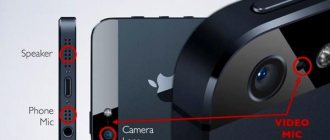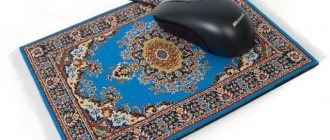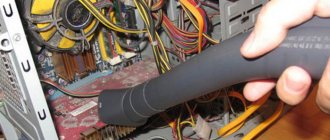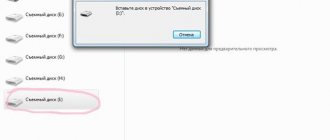| What problems can arise with a computer mouse, how to check the mouse, identify the cause of the problem and fix it yourself. |
A computer mouse is a familiar and indispensable accessory for any user of not only a PC, but also a laptop or tablet. Any problems with it can interfere with your work or rest.
But, if a computer mouse suddenly stops working, this is not a reason to throw it away and go for a new one. You can try to find and fix the problem yourself.
Mouse hardware problems
First, you should check the integrity of the device itself and the connection. If you dropped or splashed liquid on your mouse, this could be the problem. But even if you are sure that there was no mechanical damage, inspect the case and cable of the device. Make sure that nothing interferes with the operation of the optics. Check the battery of your wireless mouse.
If it's a USB mouse, try plugging it into a different port. It will be more difficult with PS/2, since the system unit usually has only one slot for it. But if there is another computer at hand, check whether the mouse will work there.
By the way, checking the mouse on another computer will allow you to determine with almost one hundred percent accuracy whether the problem is in the computer or in the accessory. You can test another mouse with this computer in the same way.
Inspect the socket on the system unit for dust, liquids, and other contact obstructions. Make sure the mouse or Bluetooth transmitter plug fits snugly but without force.
Thoroughly clean the connectors from dust and wipe the contacts with a match and a thin layer of cotton wool soaked in alcohol or use other available means.
Carry out work on cleaning the connectors only after unplugging the system unit from the outlet or removing the battery from the laptop, since even when turned off, voltage may be supplied to them.
If the connectors are oxidized, it will not be possible to completely clean them with alcohol. Repeatedly insert and remove the mouse plug into the oxidized connector until the contacts are rubbed clean.
If the problem is not detected during external inspection, the problem may be due to internal damage to the mouse. Carefully open the device case and inspect whether the contacts have come loose somewhere.
It could also be a broken wire (you can test it with an ohmmeter) and feel the wire along its entire length. This will allow you to find the break point and repair the cord.
If the mouse generally works, but the keys become stuck, often accompanied by a double click when pressed once, then you need to carefully disassemble it, clean it and bend the contact plate in the microswitches under the buttons.
If the wheel on the mouse begins to act up, which often causes reverse scrolling and weakening of the cutoffs, then you need to rinse its mechanism several times with alcohol and drop a little machine oil into it.
In most cases, this is enough and the wheel will work for a long time. But, do not rush to assemble the mouse and check its operation. If the wheel mechanism is very loose, you can gently tighten its metal frame just a little with pliers. Be extremely careful; if too much pressure is applied, this mechanism may break.
It also happens that the mouse cursor begins to move across the screen on its own. This usually means that the electronic mouse controller has started to malfunction. In this case, the problem can be solved mainly by replacing the mouse and nothing can be done about it. But don’t rush to write off the mouse as scrap, perhaps it will work fine on another computer, it happens. In addition, such problems can be caused by the mouse pad, try how the mouse will work on a clean white sheet of paper. If it’s ok, then change the rug, preferably to a plain one without patterns.
Rolling back the system to a working state
In principle, if a problem arises that the computer does not respond to the mouse, sometimes all of the above actions with drivers or rebooting may not be necessary. As practice shows, in most cases, if problems are related specifically to software failures, it is best to use a system rollback to the time point that preceded their appearance.
In this case, you can use the corresponding section in the “Control Panel”, which is called up through the “Run” menu with the control command, or force a reboot of the computer system several times by long pressing and holding the power button. The method, of course, is barbaric, but sometimes it can still be used. When starting the recovery, you will just need to follow the instructions of the “Wizard”, and if necessary, select a rollback checkpoint from the extended list yourself.
Mouse software problems
If the mouse is intact and works with other devices, then the problem may be in the software part. You can absolutely say this with confidence if another mouse behaves the same way on your PC. But there are exceptions when failures in the software appear only with a specific mouse.
One of the signs of software problems may be spontaneous movement or, conversely, a delay in cursor movement, as happens with problems with the mouse controller. In this case, it is difficult to distinguish a hardware failure from a software one. But, if hardware problems are not confirmed, then proceed to identifying software ones.
If you installed some programs and updates before the mouse failed, then the problem is almost certainly in them. Try removing them or, if possible, temporarily disabling them.
Be sure to check your computer for viruses and malware. For these purposes, I recommend using the free utility “Kaspersky Virus Removal Tool”, the latest version of which can be downloaded from the official website of the anti-virus laboratory.
If the mouse does not work at all, then go to the device manager and check whether the computer sees the mouse, USB controllers, and there are no unknown or error-prone devices.
If the device is not recognized, the descriptor request failed, or something similar, then follow these steps:
- Disconnect all peripheral devices, briefly unplug your PC, and after booting up, connect the mouse and check its operation. Some devices such as external drives, modems and some other (possibly faulty) devices can overload the USB ports with power and the mouse begins to malfunction.
- If the device is displayed with an exclamation mark, then go to the properties of this device, select the “Driver” tab and click the “Roll Back” button (if it is active) or “Delete”. Then, from the Action menu, select Update Hardware Configuration.
- You can delete outdated records about previously connected equipment (flash drives, modems, etc.). They often interfere and lead to failures of devices connected to USB. To do this, go to the View menu and select Show hidden devices. Find and remove everything you connected to the USB connectors. Don’t worry, the next time you connect, the desired device will be detected and installed again, and the problem with the mouse will disappear.
- If the problem with driver rollback and removal of old devices does not go away, then try updating the drivers, especially for USB controllers. I recommend using the free Driver Booster utility for this.
- Check your power settings. This problem usually occurs on laptops - to save energy, they turn off power to ports that have not been functioning for some time. This can be corrected in the system settings. Go to “Power management” – “Configure power plan” – “Change advanced power settings” – “USB settings”. In different versions of Windows, you can access the power settings in different ways; detailed information on this topic can be found on the Internet.
Why does the mouse pointer freeze or move slowly?
Here we are not talking about a complete stop of the pointer in place, but about intermittent movement. This can happen for various reasons, the most common of which are:
- CPU overloaded. Usually, with a large number of open programs and tabs, the PC power is not enough to provide high speed and performance.
- Disk problems. The program simply does not read some commands and does not provide normal device functions.
- Virus infection of software.
- Incorrect mouse settings. Some versions require additional setting of the sensor sensitivity in the device options.
Buy the option that matches the capabilities of your PC.
Subscribe to our Social networks
Wireless mouse problems
Most often, problems with the operation of a wireless mouse are due to a low battery. This is mainly expressed in loss of connection, spontaneous shutdown or jerky operation of the mouse.
Even if you bought and installed a new battery, there is no guarantee that it is of high quality. It is advisable to check it with a voltmeter. The voltage should be 1.3-1.5 V, otherwise lack of power can lead to problems and the battery needs to be replaced.
Problems with the operation of a wireless mouse can also be caused by poor location of the transmitter. For example, when connected to the rear connector of a PC, the signal may be greatly muffled by the metal case. Connect the transmitter either to the front panel of the case or via a USB extension cable. In the latter case, the receiver can be placed on the table right next to the mouse. In addition, this will save battery power. Well, don’t forget to use the switch on the mouse (if there is one).
If after pulling out and reinserting the receiver into the connector the mouse does not work, then try repeating this procedure with the mouse button held down.
The problem may also be interference from the Wi-Fi router. Temporarily disable it and try how the mouse behaves. If the problem disappears, you will have to select a channel in the router settings on which Wi-Fi will not interfere with the mouse. First, try the most unloaded channels, which can be found using the Wi-Fi Analyzer mobile application.
Changing the driver
For standard devices, the system installs drivers itself. But for some gaming mice, they come with the mouse itself, and you will have to install them manually. In such a situation, the drivers need to be reinstalled or updated. But what should you do if the cursor still doesn’t move?
This is where knowledge about entering commands and using the keyboard to switch between different functions, applications and system sections will come in handy. To quickly access the “Device Manager” you need to use the console call “Run” (Win + R), in which the command devmgmt.msc is entered, after which in the manager itself the movement is performed using the arrow button and tabulator. You can also use the Start menu, which is opened with the Win key. Call and button press confirmation functions are performed using the Enter key, and sometimes the Esc key is used to cancel actions.
When you reinstall a driver, the system will require you to specify its location (removable media or a folder on your hard drive) instead of using the recommended installation from the Windows database. After driver integration is complete, a reboot is recommended, although this is not always necessary.
If all else fails
If the search for hardware and software problems does not produce results, the mouse still does not work correctly, then make a backup copy of the system and install an absolutely clean one from the original image (since assemblies may contain tweaks that lead to various problems, including with the mouse).
If the problem appears on a clean system, then the problem is definitely in the mouse and it will have to be replaced. If installing a clean system solved the problem, then it’s time to set up your PC again; you will already have a clean Windows.
This way you can solve almost any problem related to the operation of the mouse. If you know other ways, write about them in the comments
Mouse A4Tech Bloody Blazing A9 Mouse A4Tech Bloody A91 Mouse A4Tech Bloody Blazing A9
Causes of freezes
All reasons for a manipulator freezing on a computer can be divided into two main types:
- hardware;
- software.
Software malfunctions are most often associated with drivers, as well as some errors within the system, or a conflict between installed equipment. With hardware errors, everything is usually much more complicated; their number is also significantly greater.
Hardware reasons for a personal computer freezing include:
The list of software faults is somewhat shorter:
- inappropriate drivers installed (old version);
- there is a conflict between different devices;
- The mouse is configured incorrectly.
Video: Setting up a mouse - the beginning
Hardware errors: solutions
The mouse freezes on the computer - what to do?
First of all, you need to check whether it is intact. If the mouse has mechanical damage, then there is a high probability that the contact on the board inside has come loose as a result of a strong impact. In the absence of a special soldering station, as well as skills, it is unlikely that it will be possible to eliminate this type of problem.
It often happens that the cause is a broken cable connecting the mouse and the USB/PS2 port. In this case, the easiest way is to purchase a new manipulator, since repairing such a breakdown will cost approximately the same as purchasing a new device.
It often happens that the computer itself (this often happens with a laptop) turns off the power to the USB root hub. This renders the mouse inoperative.
To check this, you should do the following:
If there is a tick there, then you need to remove it. Perhaps the PC is simply turning off the mouse in order to save electrical energy. In addition, you should inspect the USB connector itself as carefully as possible. It often happens that on not very high-quality boards it is poorly soldered. And if handled carelessly, the contact legs simply break.











